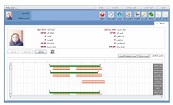No employee can be present every single day of the workweek. Human beings are not machines. There are several sorts of leave from work, including vacations, sick days, holidays, and personal reasons. Employers must be aware of these in order to create a solid leave policy and establish a system for recording when, for how long, and for what reason an employee was gone.
The majority of these sorts of leave should be included in a company's leave policy, and we will also discuss how to manage and monitor absences. We'll also examine a few strategies for reducing workplace absenteeism towards the conclusion.
What this article will tell you?
- What are the 8 main types of leave?
- Other types of leave that are less common
- Company policy on time off
- Keeping track of different kinds of time off
- Lowering absenteeism from work
The 8 main different types of leave
In general, various sorts of leave can be categorized as voluntary, involuntary, compensated, and unpaid.
When an employee schedules an absence from work, such as to go on vacation, this is considered voluntary leave. When an employee is unable to work due to medical reasons, a death in the family, etc., they are on involuntary leave.
Some types of leave are covered by the company, while others are the responsibility of the employee.
Each nation has its own legislation that establishes minimum requirements for what forms of leave and how many days an employee is responsible for, and what the government covers.
There might be significant disparities across nations, for example regarding paid vacation time. In addition, each firm has a leave policy or specifies in each employment contract how absences from work are handled, and these regulations might vary greatly from one company to the next.
1. Sick leave
As the term indicates, sick leave is granted to employees who are unwell and require time to recuperate. In addition, seclusion is often necessary to prevent the spread of the disease, as the recent COVID-19 outbreak clearly shown.
In the majority of nations, sick leave management is governed by law. A company is obligated to give an employee with a specific amount of paid sick leave, and in some countries, based on the length of sick time necessary and the severity of the sickness, the government reimburses a portion of the costs.
In certain countries, employees feel embarrassed requesting sick leave. However, this may indicate a harmful corporate culture. This can have significant long-term health effects and lead to burnout or decreased productivity.
Conversely, feigning illness is a significant breach of business policy.
2. Holiday leave
Holiday leave is when an employee takes time off for a personal vacation, such as traveling, attending family functions, or simply resting.
Most firms have rigorous policies about the amount of paid and unpaid holiday leave an employee may take annually, as well as the timing and approval procedure. Numerous nations have laws defining the minimum amount of annual vacation time.
Particularly among younger employees, enough free time and a healthy work-life balance are essential components of the remuneration package.
Occasionally, employees are willing to accept a lesser salary in exchange for greater free time and the flexibility to work remotely.
Consequently, it is essential for each organization to adopt a transparent and equitable vacation-leave policy. The amount of (paid) vacation days is one of the most often negotiated factors in addition to income.
3. Maternity and paternity leave
Maternity leave is one of the most essential sorts of leave for mothers to recuperate after childbirth and care for their newborns.
There are considerable variances across nations regarding the number of weeks a woman receives for maternity leave and the government benefits she receives.
EU nations have the longest paid maternity leave (ranging from 16 to 85 weeks), whereas the United States and Australia have the shortest paid maternity leave.
We must also remember paternity leave, which allows new dads to spend time with their children and assist the mother in the early weeks. Paternity leave is often significantly shorter, ranging from 1 to 2 weeks, and is required in certain countries, while others leave the decision up to the employer.
4. Public and religious holidays
Each nation has its own public holidays, some of which are state-based and others religious. Some of these festivals are observed on the same day in many countries.
Examples of such holidays include:
- Christmas
- New Year's Day
- Good Friday
- Easter Monday
- Labor Day
In a way, public holidays are government-provided days off.
It is essential to identify each country's holidays on the corporate calendar at the beginning of the year and organize shifts appropriately. In a time and attendance software, public and religious holidays can also be tracked.
5. Bereavement leave
Bereavement leave is for employees who have lost a loved one. It is time off intended for mourning, funeral arrangements, and other duties that accompany a death.
Typically, corporations grant their employees between one and three days of mourning vacation. In some nations, bereavement leave is required, while in others it is optional.
6. Time off in lieu (TOIL)
TOIL, or compensating leave, is associated with overtime employment. In the same way that a firm should have a leave policy, it should also have an overtime policy.
Additionally, overtime should be effectively controlled using software for overtime administration. Keeping this in mind, some businesses let workers to work extra in exchange for paid time off.
7. Sabbatical leave
In academics, sabbatical leave essentially entails taking a lengthier break from work, typically for several months.
The majority of the time, employees take sabbaticals to pursue their other interests, passions, or hobbies (such as traveling the world, studying a new subject, etc.) and occasionally to fully heal from extended periods of intense work. Typically, a sabbatical lasts between 6 and 12 months.
As a reward for their commitment and prior accomplishments, organizations frequently provide sabbaticals to long-term employees.
Some firms provide compensated or partially funded sabbatical vacation, while others offer exclusively unpaid sabbatical leave.
8. Unpaid leave
Some employers let employees take unpaid leave, which results in a salary reduction.
This is often specified in the organization's leave policy, along with the number of unpaid days an employee can take, when, the permission process, and how this affects payroll.
This is particularly useful for employees who prefer more free time than a larger paycheck.
Other less common types of leave
In addition to the major categories of leave listed above, we are also aware of a number of alternative options. This type of leave is uncommon and is not typically outlined in the company's leave policy.
However, it is recommended to be aware of them:
- Examine Military leave
- Jury service / Permission to testify as a court witness Election day
- Volunteer time off and blood donation leave
- Leave for demonstrations
- Bad weather departs
- Gardening leave upon termination of employment
Company leave policy
A company's leave policy is an internal document that specifies how absences from work are handled. Typically, a leave policy will outline the following:
- The sort of leave to which an employee is entitled
- The amount of paid leave available to an employee.
- How to apply for leave and the procedure for approval
- Procedures and punishments for violations of leave policy
A leave policy is essential for both the company and the employee, as it explains in great detail how absences are handled.
On the one hand, a leave policy ensures that employees receive the time off they deserve, while on the other, the employer can specify restrictions and repercussions for unauthorized leave.
Tracking different types of leave
After establishing a clearly defined leave policy, it is essential to frequently monitor employees' leave.
With a time and attendance system like Palizafzar Time Attendance Software, it's simple to determine when, for how long, and for what reason an employee was absent. Additionally, you may authorize absences and receive detailed absence information at the individual, team, and department levels.
A comprehensive leave-management system includes the following features:
- An interactive calendar for planning absences
- Web attendance software enables workers to submit absence requests that are subsequently approved or refused.
- The capacity to establish distinct regulations for distinct personnel.
- A clear history of approvals, so that there is no room for misunderstanding.
- Features for simple absence tracking and obtaining graphical statistics
- Team vacation management
- Functionalities to guarantee compliance with accruals
- The capacity to monitor other forms of work, such as remote work.
With a cloud-based leave management system, you can automate the process, decrease administration, and expedite and increase the transparency of absence approvals. You may test our leave management system fully for free.
Lowering absenteeism from work
Finally, let's discuss a few strategies for reducing workplace absence. We all require time off, and we can all become ill, but excessive absenteeism can have a significant impact on a company's productivity.
Long-term, company culture, leave rules, management styles, workload, and similar factors can have a significant impact on the number of days individuals are absent from work.
Here are some broad suggestions for controlling unhealthy absenteeism:
- Encourage healthy lifestyles and administer corporate wellness initiatives, such as business sporting activities, yoga courses at work, gym access, etc.
- Serve nutritious lunches at the office
- Ensure that there is no tolerance for bullying and harassment
- Encourage teamwork and positive employee connections.
- Maintain a healthy level of job stress such that it stimulates growth and prevents burnout.
- Provide flexible work choices, such as remote work
- Demonstrate concern for employees and offer assistance to those in need.
- As previously said, establish a clear leave policy and open tracking, including prompt sanctions for prohibited absences.
We have discussed the many sorts of leave, their importance, how leave should be managed and monitored, and why every firm needs a leave policy.







































































